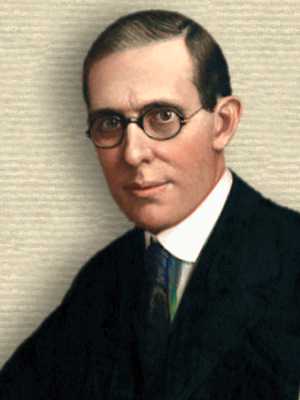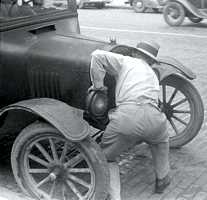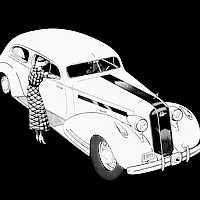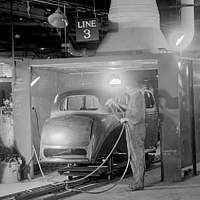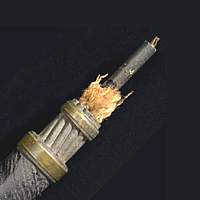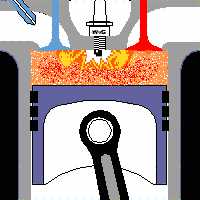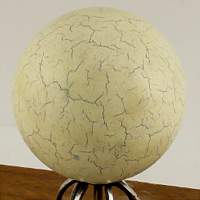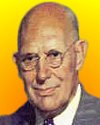 (source)
(source)
|
Charles F. Kettering
(29 Aug 1876 - 25 Nov 1958)
American engineer whose 140 patents included the electric starter, car lighting and ignition systems.
|
Great Things Are Being Done
By Men Who Think Boldly
C. F. Kettering, engineer and scientist, tells how these audacious thinkers are changing and improving the objects we constantly use—He says, for example, that the automobiles of the future will make those of to-day look like oxcarts; and that, sometime, we will learn from the grass seed and the grain of corn how to “solidify” the sun’s energy, and live on it.
By Bruce Barton
[p.24] Let us begin with the story of the Hunting Wasp! It is a typical Kettering story.
Along about the middle of the summer, when crickets are plentiful the Hunting Wasp digs a hole in the ground and deposits in it three crickets that are nice and fat. She does not kill them; she merely paralyzes them by stinging them once, and once only, in the motor nerve. She then turns the paralyzed crickets on their backs, lays an egg in a certain place on the middle cricket and closes up the nest. The egg hatches in a few days. The larva eats the crickets, spins a cocoon around itself, and lies in the silken bed until the following spring. The pupa then cuts its way out and becomes a wasp, to repeat exactly the same life cycle.
When some old ruins were excavated, a sample of the Hunting Wasp’s handiwork was found. It was done exactly as it is done to-day! In the centuries that have elapsed, the formula has not varied one iota. The Hunting Wasp changes nothing, improves nothing, asks no questions, makes no suggestions. All the mother wasp wants is food and sunshine, and a chance to lay up three crickets for her young.
Now, the trouble with the human race is that too many of us are wasps, says Mr. Kettering. We run along in the same old ruts. If somebody presents something new, we know positively that it won’t work. We think the world is finished; that things are always going to be just about the way they are now.
That’s all right, as applied to wasps; but man is different. Man is the only experiment the Lord ever tried; he is the unfinished work of the Creator. Everything else in nature operates pretty much automatically, according to the conditions imposed in the beginning.
But when the Lord came to man, He said: “I am going to let one of these creatures of mine do some thinking and see if he destroys himself or perfects himself.”
That experiment isn't finished. It’s just begun. And to insure its success we need a lot more Men and fewer Wasps; more people who will be dissatisfied with last year’s results and processes; more people who will say, “It’s a sure bet that things are going to be done differently ten years from now.” Why wait ten years? Why not do them differently now We need more people who will break into the complacent and settled routine with that annoying little word why! Man's great battle is that of intelligence versus heredity.
This, as I said, is a typical Kettering story, but it woefully lacks the fire and picturesque fervor that are C. F. Kettering. No written word can do full justice to an interview with him. One can use crisp, colloquial sentences, but they are a poor means for mirroring a mind which seems to be literally exploding into speech; and you can’t translate gestures and facial expressions into print, for they are stimulating beyond the possibilities of cold type.
If a sculptor were seeking a model for a statue of the typical Yankee, he could hardly do better than to select Mr. Kettering. He has the long, loose frame that characterized the pioneers who pushed out from New England to the Middle West. He has, too, the Yankee nasal tones, and the habit of driving abruptly to the point, without ceremony or loss of time. The city of Dayton is dotted with industries and other evidences that his habit of asking “Why?” is a profitable one to pursue.
“Why must a man get out into the mud to crank his car?” Kettering asked himself. And out of that questioning came a revolutionary system of starting, lighting, and ignition for automobiles.
“Why can’t my mother have electric lights and other modern conveniences and comforts?” he asked himself again. “Why must she be cut off from the enjoyment of these things just because she lives off the main road, on a farm?"
And from that line of thinking came an industry making electric light and power plants for farm homes and other places, together with house pumps, washing machines, and other electrical devices.
“What sort of car is the automobile of the future going to he?” asked Kettering, a third time; and that question landed him where he is to-day, vice president of the General Motors Corporation, in charge of the General Motors Research Corporation at Dayton, the largest laboratories of their kind in the world.
I visited him there some weeks ago, and asked him what he had about the [p.25] place to interest a man who doesn’t know a volt from a differential and has no desire to learn.
“Well, you might answer that in two ways,” he began, crossing his legs and leaning over the arm of his chair. “In the first place, the average man is an automobile owner these days—or is going to be—and he wants to know what the car of the future will be like. We can tell him something about that. A man came in to see me the other day.
“‘Ket,’ he said, ‘I don’t see what’s the use of all this research business. Don’t you think the automobile of to-day is just about as perfect as it ever will be?’
“‘Perfect!’ I shot back at him. 'Do you mean to tell me that if you had Aladdin’s lamp and could wish for any kind of an automobile you wanted, you would wish for the noisy, expensive, bumpy thing we sell you now? Not on your life! You’d ask for a limousine that would weigh less than a thousand pounds, sell for less than a thousand dollars, and run fifty miles on a gallon of gas. That’s what you’d want; and some day we may be able to give you something like that.
“One thing you can be sure of,” Mr. Kettering continued; “the car of the future is going to be as much better than the car of to-day as the car of to-day is better than the oxcart. Not everybody believes that. There are lots of folks with ox-cart minds, riding around in automobiles. But it’s the truth, and that’s the first thing that ought to be interesting to the average man.
“A few weeks ago we had about a dozen big automobile distributors down here.
I said to them, ‘I want each one of you to sit down and write out the improvements you would like to have made in the automobile in the next five years.’
“So they wrote out their specifications of what the car of five years from now ought to be. Then I left the papers on my desk, and took them for a tour through the laboratories, where we are working out the problems of the car of the future as we see them. When we got back to my office, one of the men reached over to the desk, picked his paper from the list, and tore it up.
“‘Hey, there,’ I said; ‘what’s the idea?’
‘“The idea?’ he responded, in a disgusted tone of voice, ‘why, we asked for a lot of little five per cent improvements. We didn’t know how to ask for enough.’
“The second thing goes nearer home. What’s your average man interested in more than his car, or his business, or anything else? He’s interested in himself of course. John Jones is glad to be told what his future car is going to be; but the principal question that occupies his mind is, ‘What is the John Jones of the future going to be?’ Well, we have some ideas on that subject, too.
“Suppose you are John Jones. The big thing in your future is to substitute new facts for old opinions. The first step is to take everything out of your desk that should not be there (and that’s about ninety per cent of the contents of the average desk), turn it around so that you can look out of a different window, or at a different stretch of wall, and then say to yourself, ‘Is this business built on fundamentals, or is it simply the result of an unstudied development?’
“First of all,” Mr. Kettering went on, “you’ve got to form the habit of thinking about problems audaciously, even extravagantly. Let me tell you a couple of stories to illustrate what I mean. One of the companies that make automobiles asked us to look into the problem of painting an automobile.
“‘How long does it take you to put a car through the paint shops?’ we asked.
“‘Thirty-one days,’ they answered.
“‘All right,’ we said ; ‘let’s start by trying to find some way of finishing a car in an hour!’
“They threw up their hands in holy horror.
“‘It can’t be done!’ they said.
“'Why not?’
“‘The paint won’t dry.’
‘“Is there anything you can do to hurry the drying?’
“‘No.’
“‘All right; then let’s get another kind of paint.’
“So we looked around, and finally we found a certain sort of enamel-like paint which is used on little metal objects— matchboxes and toilet articles and the like. We tried spraying it onto the side of a car with an air brush; and the only trouble was it dried so fast that if you didn’t hold the brush right close to the car, the paint would be hard before it hit the surface! Well, to make a long story short, we actually did finish a car in about an hour. Of course, it wasn’t exactly a handsome job; but it laid the foundation for some real results. And the point I want to make is that we never would have obtained those results if we had started to cut the thirty-one days down to thirty days, or to twenty-five days. But by starting extravagantly, by saying, ‘Let’s cut the thirty-one days down to one hour,’ we did get somewhere.
Are You Trying to Sew a Patch On Last Year’s Job?
“The big thing,” says Mr. Kettering, “is to have the courage to ask for enough. Most men think, ‘If I can do ten per cent better next year than I did last year I’m making greater progress than the average person. I’m all right.’ But what a man needs once in a while is to turn his desk around, put his feet on it, and say, ‘What I’ve done so far is nothing at all. Now, how can I make one hundred per cent progress next year? Or, how can this business double its sales? Or cut its expenses in half.
“You may never attain your ideal, if you set it so high, but you’ll go a lot further than if you wasted time trying to sew a patch on what you did the year before.”
Or, take another example: I used to be connected with the electric lighting industry, and I attended a good many of the National Electric Light Association’s conventions. I can remember the time when the fight between the electric light and the gas lamp was a draw.
“The electric light fellows said to the public, ‘All you have to do is to press a button.’ Whereupon, the gas fellows came back with a mantle and apparatus you could also work with a button. So for five years they pulled along, neck and neck, and in those five years the efficiency of the incandescent lamp increased only about five per cent.
“Well, at a meeting at Chicago, a gentleman sitting in the rear of the room who wanted to project a little frivolity into the discussion, got up and said, ‘I have a solution of our electric light problem. All we have to do is to make a lamp three hundred per cent better than the one we have. Then there won’t be any gas light competition.’
“Of course nobody paid any attention to him, because they just knew it couldn’t be done. For if, in five years there had been only a five per cent improvement, why, by the time there could be a three-hundred per cent increase in efficiency we would all be where there aren’t any artificial lights at all. Besides, what would become of the electric light companies, if the lamps were made three hundred per cent more efficient? People would need only one third of the current to get the same amount of light, and all the electric light companies would go broke. At least, that was the way the argument ran, and the meeting broke up in gloom.
“But, within five years of that meeting, the tungsten lamp had arrived and it was three hundred per cent as efficient as the old carbon lamp. But it was commercially impractical. You remember those first tungsten lamps: [p.188] if you sneezed before you got them into the sockets, the filaments broke. So the old-timers said, ‘Well, you’ve got it, but you can’t make it commercially successful.’
“Why did they say that? Because metallic tungsten is one of the hardest metals we have. It has about the same ductility as window glass, and to draw it into a filament for a lamp was regarded as a physical impossibility.
“But real scientists don’t have any word in their language that means ‘impossible.’ So a group of them got on the job, and in five or six years of very patient work they had done the thing which everybody knew ‘couldn’t be done.’ They drew metallic tungsten into a wire; and that gave us the modern lamp, which is [p.189] many times more efficient than the carbon lamp—and the filaments do not break.
“As for the electric light companies, instead of going broke they are doing more business than ever; because when people can get three hundred per cent more of a thing for the same price, they are going to use it much more freely than they did before.
“We made progress on the paint problem when we started out to cut the time from thirty-one days down to one hour; just as the electric light people made progress when they quit monkeying with five per cent improvements in five years and set out to make a three hundred per cent improvement in one year!
A good illustration of what I'm driving at is the story of the Atlantic cable. Scientists told the cable people that what they needed to make their cable really efficient was some material that would take up more magnetism than iron does. A good many engineers said very positively that such a material could not be found. Within six or seven years, scientists had been able to increase the susceptibility of iron to magnetism by only about seven per cent; and here were people that wanted a several hundred per cent increase—for that’s what they really needed. It just ‘couldn’t be done!’ and that was all there was to that.
“But someone with an audacious mind attacked the problem by trying different alloys. Of course that was flying directly in the face of all scientific knowledge— everyone knew positively that adding nickel to iron, for example, reduced iron’s magnetic powers. But the experimenter kept on; he started with ninety-nine per cent of iron and one per cent of nickel; and he kept adding one per cent of nickel and reducing the iron by one per cent. For a while, the more nickel he added to the mixture, the less susceptible it was to magnetism; and he had plenty of folks to say to him, ‘I told you so.’
“However, he went right ahead; and when he had a mixture of something over sixty per cent nickel the combination showed a susceptibility to magnetism many times that of iron! The chorus of the scientists stopped short, and a cable built up of this iron-nickel combination is about to be laid across the Atlantic.
“You can’t think audaciously if you are going to keep on being held down by all your old prejudices and preconceptions. A lot of the things we are absolutely sure about, just aren’t true at all. When you are willing to admit that, you have taken the second step in developing the spirit of scientific research.
“Here’s an example: Suppose ten years ago you had written a letter to all the leading automotive engineers in the country and asked them, ‘Why is kerosene a poorer fuel for internal combustion engines than gasolene?’ They would have told you the answer right away. They knew all about it. ‘Kerosene is not as volatile,’ they would have said; ‘it has a higher specific gravity,' and so on.
“Well, we got to experimenting, and we found out two things right away that upset some of the established beliefs:
1. That sulphuric ether, which is the most volatile liquid we have—much more volatile than gasolene—makes an engine knock worse than kerosene does.
2. That, if we used kerosene and mixed it with air, ten degrees below zero, it worked just as well as gasolene.
“In other words, after three years of experimenting, we had got far enough to know at least one thing, and that was that everything that had been positively ‘known’ on the subject before was positively wrong. Specific gravity had nothing to do with the problem. It was a question of the molecular make-up of the fuel used; the whole problem was to get the molecule to break down in just the right way.
“Now, after seven years of work, we are just beginning to know a little bit about a subject which was a closed question seven years ago. Why an automobile engine knocks and why kerosene knocks worse than gasolene. The result of this experimenting is the discovery of a material which, when added to gasolene or to kerosene, absolutely stops the knocks.
“Or, take still another subject: You remember reading in your high-school textbooks about the atom and the molecule being pretty small things. Well, they are. If a drop of water were enlarged to the size of the earth, an atom, enlarged correspondingly, would be only as big as a baseball!
“But we are beginning to find out something about these molecules and atoms. An atom is really a complete solar system. An atom of hydrogen is made up of a miniature globe containing a fixed central nucleus, comparable to our sun, with one electron or planet revolving around it. An atom of helium contains a central sun of twice the density of hydrogen, with two electronic planets revolving around it. And so on.
“A lot of the things which we thought we knew, about the differences between different sorts of matter, are not true at all. The differences consist in the number of electrons that travel around the central ‘sun,’ the velocity with which they travel, and the planes of their respective orbits.
“To put it another way: The difference between materials is the difference between [p.190] the church on the corner and the saloon across the street. They are of the same material, but one is somewhat larger than the other, and the bodies inside it are moving in different ways and at different rates of speed. Different motives, too, we might add.
“With this new knowledge of the nature of matter, it is hard to predict what we may expect. The great development in radio has come by our use of the electron, which is only a part of the atom.
“You could fill a book with the things about which we ‘knew everything’ a few years ago, and now realize that we know little or nothing. That’s the second fundamental in the scientific spirit. First, you must tackle a problem extravagantly—start out for a big result; second, you must be prepared to discard all of your preconceived notions. You must permit yourself to be ‘un-learned.’ Then, third, you must have the everlasting habit of asking ‘Why? Why? Why?’
“Most people never form that habit at all. The average man presents a difficulty, or an objection, and considers that he has said the last word on the subject. He has done his job; he has shown you that what you want to do can’t be done. He says:
“‘You can’t go outdoors in zero weather.’
“I say, ‘Why?’
“‘Because you will freeze.’
“‘Well,’ I say, ‘can’t I do something about it? Can’t I put on more clothes?’
“‘I never thought of that.’
“Or he says, ‘You can’t jump off a roof.’
‘“Why?’ I ask.
“‘Because you will hurt yourself.’
“‘Can’t I get a net?’ I ask. ‘It isn’t the jumping that hurts; it’s the stopping.’
“Well, those sound like foolish little illustrations, but you get the point. The average psychology consists of presenting an obstacle, and in sitting back comfortably as much as to say, ‘Well, that’s settled. I hope we won’t have any more discussion on that point.’
“The people who go ahead and who do constructive things are the people who, when a difficulty or an objection is presented, ask the question, ‘Can’t this difficulty be overcome?’ The man who does not progress is the man who stops the minute the objection appears.
“An expert came in to see me some time ago, a man who ‘knows all about’ glass. I said to him, ‘There are two things I want to find out. Why can we see through glass? And why can’t you make glass flexible?’
"He looked at me as if he thought I belonged in some room with the walls all covered with padding, so I wouldn’t hurt myself. He said that any fool knew why glass was transparent and why it couldn’t be flexible.
“I had a big piece of mica in my desk, and I took it out and began to bend it back and forth in a casual fashion as he talked. When he stopped, I said, ‘Here’s a pretty good start toward flexible glass. Nature apparently didn’t think it was impossible.
“So we are working in the laboratories to see whether flexible glass is not possible,’’ Mr. Kettering went on, “and we are making progress. You must always start a thing if you want to make progress.
[p.191] “Perhaps we won't succeed in making flexible glass; but, even if we don’t, we won’t be wasting our time. That’s the beautiful thing about the research spirit; it pays for itself. You may not wind up with what you went after, but you will wind up with something that will more than compensate you for your trouble.
“One of the best examples of the truth of that statement was the career of John W. Hyatt. He started out to develop a billiard ball of artificial ivory; and his search led him naturally into a study of the resiliencies of different materials. While he was making a visit to some friends who lived on a sugar plantation in the South, something happened to one of the bearings of the cane crusher. Hyatt fixed the machine, bringing into play some of the principles he had discovered in his search for the artificial billiard ball. And from that incident came the Hyatt Roller Bearing.
“But Hyatt still wanted the billiard ball. So he worked along and, after a while, he invented and developed celluloid. Still later he invented a camera film. But all this time he never abandoned his original objective; and toward the close of his life his search was rewarded. He did actually find a material that would make an artificial billiard ball; but, in the meantime, he had called into being industries that do millions of dollars’ worth of business every year.
“That story ought to encourage any man to turn the scientific spirit loose inside himself, or inside his business. Select a goal for yourself—an audacious goal. Be prepared to discard all your preconceived notions and to start out writing ‘Why?’ after everything, no matter how well established the thing may be. You’ll discover something worth while. It may not be the thing you started after, but it will be something.
“We have a couple of mottoes hung up here in the laboratories. One of them is:
“‘A problem thoroughly understood is always fairly simple.’
“That’s one of the truest sentences in the world. Find out just exactly what is wrong, and you can easily find out how to fix it. The difficulty in business is to get men who will sit down and think about a thing until they know what’s wrong. If we can find out why a thing cant be done, it is usually easy to do it.
“Another of our mottoes is: ‘In Science opinions are tolerated only when facts are lacking.’
“That is equally true. This noon, at lunch, some of my associates started to show me the sales figures of a certain business in which I am interested. I said, ‘I don’t want to see the sales figures. Why should I care about the sales figures, as long as you tell me they are ahead of last year’s? Tell me your troubles. Then we’ll find some way to fix them.’ I don’t think an executive ought ever to know the good things about his business; he is paid to know the bad things. But men dodge unpleasant new facts, and say, ‘Well, we’ve always done it this way, and I guess this is about as good a way as any; whereas they ought to know that because they have always done it this way is prima facie evidence that there must be some better way.
[p.192] “All of which brings us back to where we started” Mr. Kettering concluded; “back to the absurd idea that the world is finished. We talk about the conquest of nature, when what we ought to talk about is the conquest of our own ignorance. Nature is all right; the powers and resources of nature which we have discovered were always there, waiting to be put to work. What hindered us was our own incapacity to think.
“You remember Laplace, the great astronomer. He spent his life in scientific research and died at seventy-eight. With his dying breath he exclaimed, ‘What we know is nothing; what we do not know is immense.’
“Contrast that with a sentence that was once framed in the physics laboratory of one of our colleges. It said: ‘All the important principles involved in physics have been discovered.’ Can you imagine a more arrogant piece of nonsense than that?
“What has been discovered is nothing in comparison with the vast realms still unexplored. I say to our folks in the laboratories that we have three problems: (1) To make a car that will do everything the finest car can do to-day, but that will weigh less than a thousand pounds and will sell for less than a thousand dollars; (2) To make it run at least fifty miles on a gallon of gas; and (3) To find out why the grass is green.
“That last may sound foolish. But wait a minute: Have you ever considered the miracle of the grass seed, or of the kernel of corn? You plant a grain of corn; and in ninety days, or such a matter, you get a corn stalk weighing 2,300 or 2,100 times as much as the original seed. So you can burn that corn stalk and get light and heat; and when you are through only five per cent remains in ash. You can take that five per cent of ash, put it back into the ground, plant another grain of corn—and keep that process going ad infinitum.
“Now, where did the ninety-five per cent come from? The sun fabricated it from the air and water. The grain of corn knows a trick that no scientist knows—how to take solar energy and solidify it by forming organic compounds. Our clothes, our food, the wood in our houses are all nothing but the results of the sunshine of bygone years. That’s what we live on. Our problem is to find out how to solidify this year’s sunshine—how to live on it direct, the way the grain of corn does, or the grass seed. When we learn that trick, when we know why grass is green, and how the grain of corn becomes a corn stalk, then we shall have a right to draw a long breath and settle back and think that we have done something. All our oil and coal are just the sun’s bank account; its energy, stored away for us to use until we learn how to catch it on the fly.
“And we will learn some day. More scientific minds are at work now than ever before, and their endeavor is better organized. Most of the great discoveries and inventions of the future will come from the laboratories where groups of scientists start with all the facts which have been developed up to that time, and go forward along certain well-organized paths, testing one material and process [p.193] after another and recording their results.
“This sort of correlated thinking, which takes the past only as a starting point from which to proceed, will give us discoveries in the next few years beyond anything we can now imagine. Those discoveries will involve big changes, but we needn’t worry about that.
“When I was a boy on the farm, the farmers around us were worrying about what they would do for rail fences when all the trees were gone. But long before the trees were gone, the rail fences had been supplanted with wire ones.
“Some automobile men to-day worry about what will happen to the automobile business when everybody has a car. Did you ever stop to think what happened to the cars that didn’t have self-starters, after the self-starter was invented? Inside of three years, you couldn’t find one. They weren’t worn out; they were just discarded. So with the automobile business; the car of the future is going to be so much better than the car of to-day that it will be cheaper to throw away your old car than to keep on running it.
Fabre, the French scientist who wrote so entertainingly about wasps and bees and other insects, said a very wise thing: ‘The man who thinks of the future is always out of style to-day.’
“If the scientist has any message for the man in business, it is: ‘For heaven’s sake, have the courage to be out of style. Think audaciously. Turn your desk around; clear the papers off it; put your feet on it; and think. Don’t do to-day the same thing you did yesterday in just the same way. The Hunting Wasp has followed that rule for thousands of years —and it is just exactly where it started.’”
- Science Quotes by Charles F. Kettering.
- 29 Aug - short biography, births, deaths and events on date of Kettering's birth.
- Short Stories of Science and Invention - Index to A Collection of Radio Talks by Charles F. Kettering
- Charles Franklin Kettering: A Biography, by T. A. Boyd. - book suggestion.
